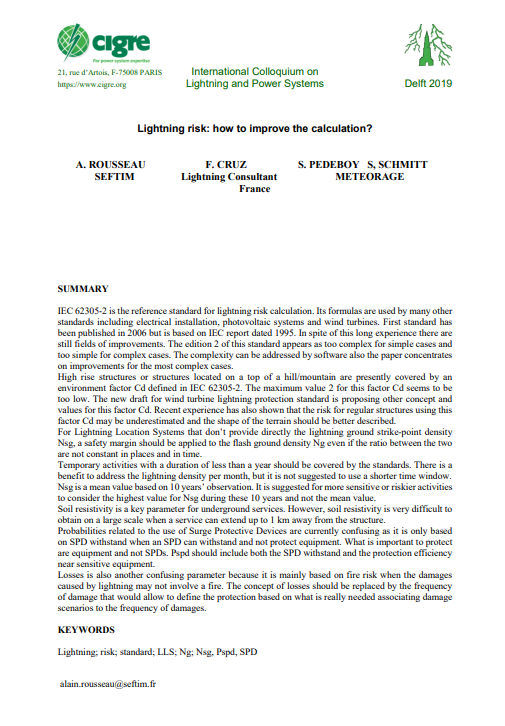Risque foudre : comment améliorer le calcul (IEC 62305-2) ?
Résumé (en anglais)
IEC 62305-2 is the reference standard for lightning risk calculation. Its formulas are used by many other standards including electrical installation, photovoltaic systems and wind turbines.
First standard has been published in 2006 but is based on IEC report dated 1995. In spite of this long experience there are still fields of improvements. The edition 2 of this standard appears as too complex for simple cases and too simple for complex cases. The complexity can be addressed by software also the paper concentrates on improvements for the most complex cases.
High rise structures or structures located on a top of a hill/mountain are presently covered by an environment factor Cd defined in IEC 62305-2. The maximum value 2 for this factor Cd seems to be too low. The new draft for wind turbine lightning protection standard is proposing other concept and values for this factor Cd. Recent experience has also shown that the risk for regular structures using this factor Cd may be underestimated and the shape of the terrain should be better described. For Lightning Location Systems that don’t provide directly the lightning ground strike-point density Nsg, a safety margin should be applied to the flash ground density Ng even if the ratio between the two are not constant in places and in time. Temporary activities with a duration of less than a year should be covered by the standards.
There is a benefit to address the lightning density per month, but it is not suggested to use a shorter time window. Nsg is a mean value based on 10 years’ observation. It is suggested for more sensitive or riskier activities to consider the highest value for Nsg during these 10 years and not the mean value.
Soil resistivity is a key parameter for underground services. However, soil resistivity is very difficult to obtain on a large scale when a service can extend up to 1 km away from the structure. Probabilities related to the use of Surge Protective Devices are currently confusing as it is only based on SPD withstand when an SPD can withstand and not protect equipment. What is important to protect are equipment and not SPDs. Pspd should include both the SPD withstand and the protection efficiency near sensitive equipment.
Losses is also another confusing parameter because it is mainly based on fire risk when the damages caused by lightning may not involve a fire. The concept of losses should be replaced by the frequency of damage that would allow to define the protection based on what is really needed associating damage scenarios to the frequency of damages.

